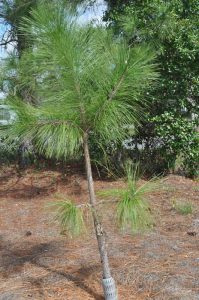by UF/IFAS Extension Polk County Master Gardener, Celia Beamish
My favorite native tree is the native pine. Of course, there are several native pines, so a person with a bigger yard than mine could have a collection! Would that be cool or what?
The first one I’d plant would be the longleaf pine, Pinus palustris. The thing about these trees that’s so adorable is the growth stages they go through. At first they go into what is technically called a ‘grass phase’ which is actually the pine tree channeling Cousin It from The Addams Family. Seriously. For a period of 2+ years all you get is a fuzzy clump of needles. It’s a hoot. Once the tree has enough energy stored in roots underground, it springs into adolescence, complete with amazingly long legs and gangling branches. (Scientists think that this is an adaptation that helps the heart of the young tree survive frequent grass fires.)

After the tree grows enough to stop looking silly, the long, silky needles begin to droop beguilingly and rustle in every little breeze. Pines (of course) make pine cones, and these smell delicious when they are fresh. In fact, pine sap in general smells delicious. My dad was raised on a ranch and until he was a teen, the only chewing gum available was that found on the side of a wounded pine tree. Of course he taught us all to chew pine gum as well. Pine gum or sap is not a taste everyone relishes, but since I’ve known it from a child, I find it to be delicious. Plus it gives your jaw muscles great exercise trying to open back up after each chomp.

Each year, in the spring, the branches develop new growth clusters that are silvery, which is where the pollen and the cones develop. Then the branches elongate. Since they are often pale yellow, they’re commonly called candles.
The tree grows slowly up to 80 feet or so. (The way you tell if a pine is mature is that the crown becomes rounded instead of pointy.) Between the Cousin It stage and old age, however, these pines make wonderful living holiday trees, and can be decorated with strings of popcorn and other bird treats. Or even twinkly lights, if you like!
I don’t see many longleaf pines in gardens – they don’t transplant well and are best planted as a seed. (They germinate right away, so don’t dawdle if you intend to plant some, and plant seeds under an inch or so of soil, not on the surface.) And of course, developers prefer ‘pretty’ plants. Cousin It need not apply! If you do find a longleaf pine in the wild, keep your eyes open for our handsome native fox squirrel. Unfortunately, fox squirrels have quite a bump of curiosity, and this characteristic has resulted in them becoming rarer and rarer. You might see a beautiful turkey oak in the same environment as the longleaf pine – check out the size of those acorns!

Web sites:
http://gardeningsolutions.ifas.ufl.edu/plants/trees-and-shrubs/trees/longleaf-pine.html
Picture sources:
Picture of Cousin It: Longleaf pine (Pinus palustris) seedling. Joseph O’Brien, USDA Forest Service, Bugwood.org.
Picture of adolescent: http://baker.ifas.ufl.edu/Arboretum/LongleafPine.html
Fox squirrel: Photo credit: Florida Fish and Wildlife Conservation Commission
 1
1
